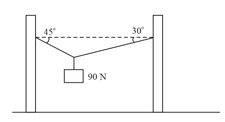Name the fundamental forces In nature.
Important Questions on Physical World
(A) Ratio of the relative strength of gravitational to weak force is nearly
(B) Ratio of the relative strength of gravitational to weak force is less than
(C) Ratio of the relative strength of strong nuclear to electromagnetic force is nearly
(D) Ratio of the relative strength of strong nuclear to electromagnetic force is nearly .
Which of the following is true?
Two blocks and are placed one over the other on a smooth horizontal surface. The maximum horizontal force that can be applied on lower block , so that and move without separation is . The coefficient of friction between and is

| Column I | Column II | ||
| A | Stoke's law | I | Pressure and energy |
| B | Turbulence | II | Hydraulic lift |
| C | Bernoulli's Principle | III | Viscous drag |
| D | Pascal's law | IV | Reynold's number |
The correct match is
A rectangular frame of some mass has to be suspended symmetrically by two mass-less strings of equal length on two supports. It can be done in one of the three following ways as shown in below figures. The tension in the strings will be

A maximum of force can be applied on a block, down the incline, that would still not move the block which is placed on a rough inclined plane as shown in the figure. The maximum external force up the inclined plane that does not move the block is . The coefficient of static friction between the block and the plane is

A mass is hung on a rope tied between two poles as shown in the figure. The tension and in the two parts of the rope are (in )


(i) The strong nuclear force binds protons and neutrons in a nucleus.
(ii) The strong nuclear force is about times the electromagnetic force in strength.
(iii) The weak nuclear force is the weakest of all the four fundamental forces.
(iv) The range of the weak nuclear is about
The correct statement(s) is (are)

